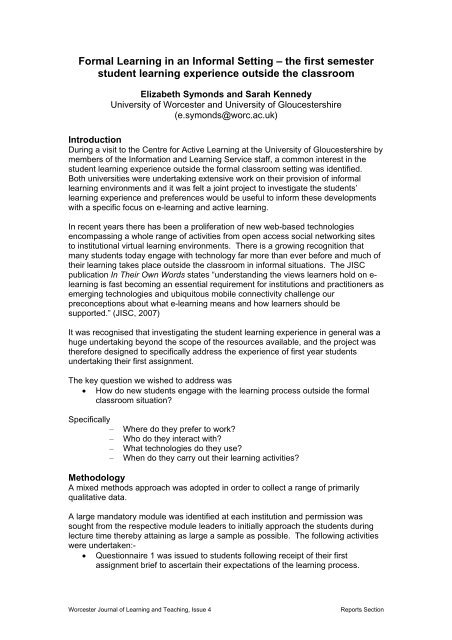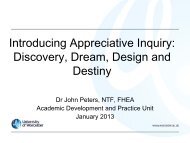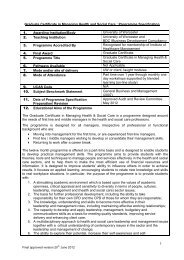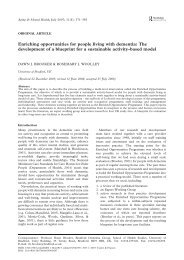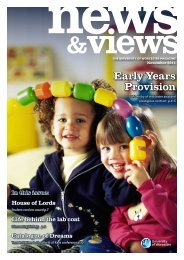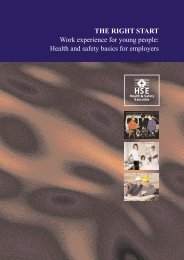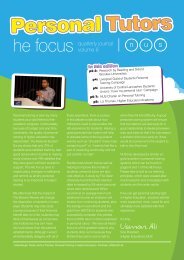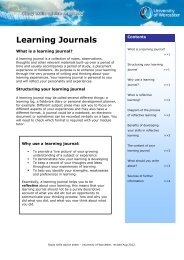Formal Learning in an Informal Setting - University of Worcester
Formal Learning in an Informal Setting - University of Worcester
Formal Learning in an Informal Setting - University of Worcester
You also want an ePaper? Increase the reach of your titles
YUMPU automatically turns print PDFs into web optimized ePapers that Google loves.
<strong>Formal</strong> <strong>Learn<strong>in</strong>g</strong> <strong>in</strong> <strong>an</strong> <strong>Informal</strong> Sett<strong>in</strong>g – the first semester<br />
student learn<strong>in</strong>g experience outside the classroom<br />
Elizabeth Symonds <strong>an</strong>d Sarah Kennedy<br />
<strong>University</strong> <strong>of</strong> <strong>Worcester</strong> <strong>an</strong>d <strong>University</strong> <strong>of</strong> Gloucestershire<br />
(e.symonds@worc.ac.uk)<br />
Introduction<br />
Dur<strong>in</strong>g a visit to the Centre for Active <strong>Learn<strong>in</strong>g</strong> at the <strong>University</strong> <strong>of</strong> Gloucestershire by<br />
members <strong>of</strong> the Information <strong>an</strong>d <strong>Learn<strong>in</strong>g</strong> Service staff, a common <strong>in</strong>terest <strong>in</strong> the<br />
student learn<strong>in</strong>g experience outside the formal classroom sett<strong>in</strong>g was identified.<br />
Both universities were undertak<strong>in</strong>g extensive work on their provision <strong>of</strong> <strong>in</strong>formal<br />
learn<strong>in</strong>g environments <strong>an</strong>d it was felt a jo<strong>in</strong>t project to <strong>in</strong>vestigate the students’<br />
learn<strong>in</strong>g experience <strong>an</strong>d preferences would be useful to <strong>in</strong>form these developments<br />
with a specific focus on e-learn<strong>in</strong>g <strong>an</strong>d active learn<strong>in</strong>g.<br />
In recent years there has been a proliferation <strong>of</strong> new web-based technologies<br />
encompass<strong>in</strong>g a whole r<strong>an</strong>ge <strong>of</strong> activities from open access social network<strong>in</strong>g sites<br />
to <strong>in</strong>stitutional virtual learn<strong>in</strong>g environments. There is a grow<strong>in</strong>g recognition that<br />
m<strong>an</strong>y students today engage with technology far more th<strong>an</strong> ever before <strong>an</strong>d much <strong>of</strong><br />
their learn<strong>in</strong>g takes place outside the classroom <strong>in</strong> <strong>in</strong>formal situations. The JISC<br />
publication In Their Own Words states “underst<strong>an</strong>d<strong>in</strong>g the views learners hold on e-<br />
learn<strong>in</strong>g is fast becom<strong>in</strong>g <strong>an</strong> essential requirement for <strong>in</strong>stitutions <strong>an</strong>d practitioners as<br />
emerg<strong>in</strong>g technologies <strong>an</strong>d ubiquitous mobile connectivity challenge our<br />
preconceptions about what e-learn<strong>in</strong>g me<strong>an</strong>s <strong>an</strong>d how learners should be<br />
supported.” (JISC, 2007)<br />
It was recognised that <strong>in</strong>vestigat<strong>in</strong>g the student learn<strong>in</strong>g experience <strong>in</strong> general was a<br />
huge undertak<strong>in</strong>g beyond the scope <strong>of</strong> the resources available, <strong>an</strong>d the project was<br />
therefore designed to specifically address the experience <strong>of</strong> first year students<br />
undertak<strong>in</strong>g their first assignment.<br />
The key question we wished to address was<br />
• How do new students engage with the learn<strong>in</strong>g process outside the formal<br />
classroom situation?<br />
Specifically<br />
– Where do they prefer to work?<br />
– Who do they <strong>in</strong>teract with?<br />
– What technologies do they use?<br />
– When do they carry out their learn<strong>in</strong>g activities?<br />
Methodology<br />
A mixed methods approach was adopted <strong>in</strong> order to collect a r<strong>an</strong>ge <strong>of</strong> primarily<br />
qualitative data.<br />
A large m<strong>an</strong>datory module was identified at each <strong>in</strong>stitution <strong>an</strong>d permission was<br />
sought from the respective module leaders to <strong>in</strong>itially approach the students dur<strong>in</strong>g<br />
lecture time thereby atta<strong>in</strong><strong>in</strong>g as large a sample as possible. The follow<strong>in</strong>g activities<br />
were undertaken:-<br />
• Questionnaire 1 was issued to students follow<strong>in</strong>g receipt <strong>of</strong> their first<br />
assignment brief to ascerta<strong>in</strong> their expectations <strong>of</strong> the learn<strong>in</strong>g process.<br />
<strong>Worcester</strong> Journal <strong>of</strong> <strong>Learn<strong>in</strong>g</strong> <strong>an</strong>d Teach<strong>in</strong>g, Issue 4<br />
Reports Section
• Follow-up focus groups were held with volunteers to develop the questions<br />
further <strong>an</strong>d elicit a richer depth <strong>of</strong> detail.<br />
• Questionnaire 2 was issued after assignment feedback had been received<br />
early <strong>in</strong> semester 2.<br />
• Follow-up focus groups were held with the same students.<br />
• Tutor <strong>in</strong>terviews were held to ascerta<strong>in</strong> the pedagogic approach taken.<br />
A total <strong>of</strong> 163 particip<strong>an</strong>ts completed questionnaire 1 <strong>an</strong>d 102 completed<br />
questionnaire 2. Focus groups were attended by 16 students <strong>in</strong> the first semester<br />
<strong>an</strong>d 11 <strong>in</strong> the second. A demographic breakdown <strong>of</strong> particip<strong>an</strong>ts <strong>in</strong> terms <strong>of</strong> age <strong>an</strong>d<br />
gender across each <strong>in</strong>stitution c<strong>an</strong> be found <strong>in</strong> appendix 1, however the vast majority<br />
(83%) <strong>of</strong> particip<strong>an</strong>ts were aged 18 – 21.<br />
Key F<strong>in</strong>d<strong>in</strong>gs<br />
The study yielded <strong>an</strong> overwhelm<strong>in</strong>g qu<strong>an</strong>tity <strong>of</strong> rich data <strong>an</strong>d here the key themes<br />
<strong>an</strong>d trends have been identified <strong>an</strong>d are illustrated with appropriate quotations from<br />
the questionnaires <strong>an</strong>d focus group.<br />
Where do students prefer to work?<br />
Unsurpris<strong>in</strong>gly, the most common places cited by students were their own home or<br />
room or the library/study centre. Individual preferences varied with some stat<strong>in</strong>g a<br />
def<strong>in</strong>ite preference<br />
“...corner <strong>of</strong> the library on my laptop – it’s the best way to do it for me”<br />
“In my room as it is quiet <strong>an</strong>d has most <strong>of</strong> my resources.”<br />
However the study found that 76% <strong>of</strong> the particip<strong>an</strong>ts used a comb<strong>in</strong>ation <strong>of</strong> both the<br />
library/learn<strong>in</strong>g centre <strong>an</strong>d their own home or room. In general students preferred to<br />
use the library when research<strong>in</strong>g <strong>an</strong>d gather<strong>in</strong>g resources to <strong>in</strong>form their work but<br />
preferred to do the writ<strong>in</strong>g up at home.<br />
“On my laptop <strong>in</strong> my room as I c<strong>an</strong> focus better or <strong>in</strong> the <strong>Learn<strong>in</strong>g</strong> Centre<br />
where I have m<strong>an</strong>y resources.”<br />
“My room – it’s quiet <strong>an</strong>d <strong>an</strong> environment I’m familiar with. The library for <strong>an</strong>y<br />
research needed etc.”<br />
One <strong>of</strong> the key themes that came out <strong>of</strong> this question was the issue <strong>of</strong> distractions.<br />
There is <strong>an</strong> assumption that the “net generation” or “digital natives” are multi-taskers<br />
able to work <strong>an</strong>ytime <strong>an</strong>y place(Prensky, 2001), however m<strong>an</strong>y <strong>of</strong> the students <strong>in</strong> the<br />
study specifically chose their preferred work place because there were no<br />
distractions.<br />
“My room because it is a private place with no one around distract<strong>in</strong>g me.”<br />
“…I prefer work<strong>in</strong>g <strong>in</strong> the learn<strong>in</strong>g centre <strong>an</strong>yway – at home I just do other<br />
stuff”<br />
Students clearly still rely heavily <strong>of</strong> the resources provided by the <strong>University</strong> both <strong>in</strong><br />
terms <strong>of</strong> physical resources such as learn<strong>in</strong>g spaces, comput<strong>in</strong>g facilities, books <strong>an</strong>d<br />
journals, but also virtual resources such as the VLE, e-journals <strong>an</strong>d e-books which<br />
they expect to be able to access from home as well as on campus.<br />
<strong>Worcester</strong> Journal <strong>of</strong> <strong>Learn<strong>in</strong>g</strong> <strong>an</strong>d Teach<strong>in</strong>g, Issue 4<br />
Reports Section
A wide variety <strong>of</strong> learn<strong>in</strong>g styles <strong>an</strong>d preferences were found <strong>an</strong>d this creates a need<br />
for universities to recognise the diversity amongst the students <strong>an</strong>d provide learn<strong>in</strong>g<br />
spaces which c<strong>an</strong> cater for all styles from <strong>in</strong>dividual quiet study areas to <strong>in</strong>formal<br />
group learn<strong>in</strong>g environments. (Obl<strong>in</strong>ger, 2008)<br />
Who do they <strong>in</strong>teract with?<br />
Individual preferences for group work<strong>in</strong>g or work<strong>in</strong>g alone were fairly evenly split with<br />
43% preferr<strong>in</strong>g to work alone, 35% preferr<strong>in</strong>g group work <strong>an</strong>d 22% <strong>in</strong>dicat<strong>in</strong>g both.<br />
Where work<strong>in</strong>g alone was preferred there was a strong concern for m<strong>an</strong>y students<br />
regard<strong>in</strong>g the contribution <strong>of</strong> all group members <strong>an</strong>d the fairness <strong>of</strong> a s<strong>in</strong>gle mark for<br />
the group as whole rather th<strong>an</strong> be<strong>in</strong>g marked on their own contribution.<br />
“We had a guy <strong>in</strong> our group – we did all the presentation – he sent us a slide<br />
on Sunday but it happened to be bl<strong>an</strong>k!”<br />
“I prefer to work alone because that way you don't have to rely on others to<br />
do their part, if they don't your mark will depend on them.”<br />
“I c<strong>an</strong> rely on myself <strong>an</strong>d know that I c<strong>an</strong> put 100% <strong>in</strong>to my work. I don't have<br />
to worry about others not putt<strong>in</strong>g effort <strong>in</strong>to the assignment.”<br />
Some students stated that their preference varied depend<strong>in</strong>g on the nature <strong>of</strong> the<br />
task, however m<strong>an</strong>y enjoyed the shar<strong>in</strong>g <strong>of</strong> ideas <strong>an</strong>d the feedback from their peers<br />
<strong>in</strong> group work<strong>in</strong>g:<br />
“Work<strong>in</strong>g together allows you to ask each other questions about the essay<br />
<strong>an</strong>d solve <strong>an</strong>y problems you may have. “<br />
“With others because it helps me to underst<strong>an</strong>d what the question is ask<strong>in</strong>g<br />
me, the types <strong>of</strong> th<strong>in</strong>gs I could <strong>in</strong>clude <strong>an</strong>d I prefer be<strong>in</strong>g able to discuss<br />
ideas.”<br />
Both the modules <strong>in</strong> the study had <strong>an</strong> element <strong>of</strong> group work as part <strong>of</strong> the assessed<br />
component <strong>an</strong>d <strong>in</strong> the reflections focus groups this was found to have worked better<br />
th<strong>an</strong> expected by m<strong>an</strong>y <strong>of</strong> the students. The group tasks had been org<strong>an</strong>ized <strong>in</strong> such<br />
a way as to ensure <strong>an</strong> equal contribution from all group members <strong>an</strong>d this was seen<br />
as supportive <strong>an</strong>d useful:<br />
“We made groups <strong>in</strong> the sem<strong>in</strong>ar groups….<strong>an</strong>d then come back <strong>an</strong>d read it<br />
out so that the lecturers c<strong>an</strong> see that we know what we’re do<strong>in</strong>g, not just<br />
go<strong>in</strong>g <strong>in</strong>to it bl<strong>in</strong>d <strong>an</strong>d completely wrong.”<br />
“… it was useful hav<strong>in</strong>g someone else because you both come up with<br />
different ideas for the essay…”<br />
What technologies do they use?<br />
In the questionnaire m<strong>an</strong>y students provided very general <strong>an</strong>swers to this question<br />
such as “a computer” or “my laptop”. This would support the f<strong>in</strong>d<strong>in</strong>g that “technology”<br />
is very much taken for gr<strong>an</strong>ted by m<strong>an</strong>y younger students <strong>an</strong>d embedded <strong>in</strong>to their<br />
everyday lives. (Ipsos MORI, 2007) There was also <strong>an</strong> assumption that learn<strong>in</strong>g<br />
resources would be provided electronically <strong>an</strong>d use <strong>of</strong> the Virtual <strong>Learn<strong>in</strong>g</strong><br />
Environment was somewhat taken for gr<strong>an</strong>ted:<br />
<strong>Worcester</strong> Journal <strong>of</strong> <strong>Learn<strong>in</strong>g</strong> <strong>an</strong>d Teach<strong>in</strong>g, Issue 4<br />
Reports Section
“I believe that it’s the tutors not follow<strong>in</strong>g through by putt<strong>in</strong>g it on WebCT that<br />
holds a lot <strong>of</strong> students back”<br />
“…it’s all on Blackboard”<br />
Despite the widespread use <strong>of</strong> computers <strong>an</strong>d technologies such as social<br />
network<strong>in</strong>g <strong>an</strong>d basic web search<strong>in</strong>g, there is evidence to suggest that m<strong>an</strong>y<br />
students beg<strong>in</strong> university with a lack <strong>of</strong> some <strong>of</strong> the <strong>in</strong>formation literacy skills needed<br />
for study<strong>in</strong>g <strong>in</strong> Higher Education (Obl<strong>in</strong>ger, 2008). This study also found a large<br />
degree <strong>of</strong> variation <strong>in</strong> the level <strong>of</strong> digital literacy possessed by the particip<strong>an</strong>ts with<br />
some openly acknowledg<strong>in</strong>g their shortcom<strong>in</strong>gs:<br />
“I need some lessons on the <strong>in</strong>ternet”<br />
“I’m still confused on how to reference the <strong>in</strong>ternet properly”<br />
Other respondents however demonstrated good underst<strong>an</strong>d<strong>in</strong>gs <strong>of</strong> the concepts <strong>of</strong><br />
validity <strong>an</strong>d reliability <strong>an</strong>d Wikipedia was mentioned by m<strong>an</strong>y respondents as <strong>an</strong><br />
unreliable source:<br />
“I used the Library Uni <strong>in</strong>ternet resources because they’re easy to use <strong>an</strong>d<br />
you c<strong>an</strong> access papers <strong>an</strong>d type <strong>in</strong> key words…you know you’re gett<strong>in</strong>g what<br />
you need.<br />
“… you don’t use the Wikipedia pages as a quote, as a reference but you c<strong>an</strong><br />
use Wikipedia to f<strong>in</strong>d someth<strong>in</strong>g else…use it to f<strong>in</strong>d other th<strong>in</strong>gs which were<br />
acceptable”<br />
“I th<strong>in</strong>k that Wikipedia is really good but I accept that as far as writ<strong>in</strong>g this<br />
essay goes, you mustn’t quote from it”<br />
Computer ownership was not a question specifically addressed however the<br />
responses <strong>in</strong>dicated a high level <strong>of</strong> computer ownership. Students do however still<br />
rely heavily on university provided comput<strong>in</strong>g facilities as m<strong>an</strong>y do not w<strong>an</strong>t to br<strong>in</strong>g<br />
their own laptops onto campus due to concerns <strong>of</strong> security or <strong>in</strong>convenience<br />
(JISC/Ipsos Mori, 2008).<br />
“Then <strong>of</strong> course there’s not enough computers so I ended up buy<strong>in</strong>g a laptop<br />
which has helped me a lot. I don’t th<strong>in</strong>k I would have been able to do it<br />
without that”<br />
“I just used the PC at home that was the ma<strong>in</strong> th<strong>in</strong>g”<br />
Despite the widespread use <strong>of</strong> social network<strong>in</strong>g s<strong>of</strong>tware amongst young people<br />
(JISC/Ipsos Mori,2008, Obl<strong>in</strong>ger 2008) the students <strong>in</strong> our study did not recognise it<br />
as play<strong>in</strong>g a part <strong>in</strong> their learn<strong>in</strong>g, more as a distraction:<br />
“There are so m<strong>an</strong>y distractions on the <strong>in</strong>ternet – Facebook!”<br />
The use <strong>of</strong> technology for the sake <strong>of</strong> it was also a major cause <strong>of</strong> dissatisfaction for<br />
some <strong>of</strong> the students especially if they could not see the relev<strong>an</strong>ce <strong>of</strong> it.<br />
“…we had to use OneNote … it’s po<strong>in</strong>tless I could just do that <strong>in</strong> a new folder<br />
on a computer”<br />
<strong>Worcester</strong> Journal <strong>of</strong> <strong>Learn<strong>in</strong>g</strong> <strong>an</strong>d Teach<strong>in</strong>g, Issue 4<br />
Reports Section
There is a wealth <strong>of</strong> current research <strong>in</strong>to the student learn<strong>in</strong>g experience with<br />
particular focus on the use <strong>of</strong> technologies for learn<strong>in</strong>g <strong>an</strong>d m<strong>an</strong>y <strong>of</strong> these are<br />
beg<strong>in</strong>n<strong>in</strong>g to question the whole notion <strong>of</strong> the “Digital Native” <strong>an</strong>d the assumptions<br />
about their experience <strong>an</strong>d expertise <strong>in</strong> us<strong>in</strong>g technology for learn<strong>in</strong>g. (Kennedy et<br />
al, 2008, Margary<strong>an</strong> <strong>an</strong>d Littlejohn, 2008). This project has also highlighted a<br />
number <strong>of</strong> <strong>an</strong>omalies <strong>in</strong> how students engage with technology which support these<br />
f<strong>in</strong>d<strong>in</strong>gs.<br />
When do they carry out their learn<strong>in</strong>g activities?<br />
The majority <strong>of</strong> students participat<strong>in</strong>g <strong>in</strong> the focus groups said that they left the<br />
completion <strong>of</strong> their assignments to the last m<strong>in</strong>ute.<br />
“I thought I wasn’t go<strong>in</strong>g to f<strong>in</strong>ish <strong>in</strong> time because I literally left it to the last<br />
day”<br />
“Well I did a lot <strong>of</strong> pl<strong>an</strong>n<strong>in</strong>g but I actually only wrote the essay the day before<br />
it was <strong>in</strong>”<br />
“It’s usually <strong>in</strong> the even<strong>in</strong>g when I do m<strong>in</strong>e <strong>an</strong>d I tend to leave it to the last<br />
m<strong>in</strong>ute because it’s that contraction <strong>of</strong> time that gets me focused on do<strong>in</strong>g it”<br />
However, when asked what they would ch<strong>an</strong>ge most <strong>of</strong> them said they would start<br />
sooner.<br />
This f<strong>in</strong>d<strong>in</strong>g may supports Prensky’s orig<strong>in</strong>al claim that digital natives prefer receiv<strong>in</strong>g<br />
<strong>in</strong>formation quickly <strong>an</strong>d are adept at process<strong>in</strong>g <strong>in</strong>formation rapidly whilst multitask<strong>in</strong>g<br />
(Prensky, 2001), however, it could also highlight the fact that m<strong>an</strong>y students<br />
have poor time m<strong>an</strong>agement <strong>an</strong>d org<strong>an</strong>isational skills.<br />
Conclusions/Recommendations<br />
This study has exam<strong>in</strong>ed students’ expectations <strong>an</strong>d experiences <strong>of</strong> study<strong>in</strong>g for <strong>an</strong>d<br />
complet<strong>in</strong>g their first assignment <strong>in</strong> Higher Educations. As a primarily qualitative<br />
study our f<strong>in</strong>d<strong>in</strong>gs are illustrative rather th<strong>an</strong> statistically reliable however m<strong>an</strong>y <strong>of</strong> our<br />
f<strong>in</strong>d<strong>in</strong>gs have reflected current research <strong>in</strong> this area which would <strong>in</strong>dicate a broader<br />
application <strong>of</strong> our results.<br />
Recommendations<br />
Information <strong>an</strong>d <strong>Learn<strong>in</strong>g</strong> Services should cont<strong>in</strong>ue to provide a r<strong>an</strong>ge <strong>of</strong> learn<strong>in</strong>g<br />
spaces to accommodate all learn<strong>in</strong>g styles <strong>an</strong>d preferences <strong>in</strong>clud<strong>in</strong>g quiet study<br />
areas, group work areas <strong>an</strong>d <strong>in</strong>formal learn<strong>in</strong>g spaces.<br />
Where group activities are part <strong>of</strong> the summative assessment, mech<strong>an</strong>isms<br />
should be put <strong>in</strong> place to ensure that all group members’ <strong>in</strong>dividual contributions<br />
are <strong>in</strong>cluded <strong>in</strong> the mark<strong>in</strong>g process<br />
Where a new or unfamiliar technology is <strong>in</strong>troduced as part <strong>of</strong> the assessed<br />
component it should be relev<strong>an</strong>t, embedded <strong>an</strong>d fully supported throughout the<br />
module.<br />
ILS <strong>an</strong>d student services should cont<strong>in</strong>ue to work together to provide a r<strong>an</strong>ge <strong>of</strong><br />
support activities <strong>an</strong>d resources for new students to bridge the tr<strong>an</strong>sition <strong>in</strong>to HE.<br />
In particular focuss<strong>in</strong>g on digital literacies <strong>an</strong>d time m<strong>an</strong>agement skills.<br />
Implications for learn<strong>in</strong>g teach<strong>in</strong>g <strong>an</strong>d assessment<br />
<strong>Worcester</strong> Journal <strong>of</strong> <strong>Learn<strong>in</strong>g</strong> <strong>an</strong>d Teach<strong>in</strong>g, Issue 4<br />
Reports Section
The <strong>in</strong>creas<strong>in</strong>g numbers <strong>an</strong>d diversity <strong>of</strong> students enter<strong>in</strong>g higher education is putt<strong>in</strong>g<br />
<strong>in</strong>stitutions under <strong>in</strong>creas<strong>in</strong>g pressure. Listen<strong>in</strong>g to the student voice is vital if we are<br />
to cont<strong>in</strong>ue to provide the tools <strong>an</strong>d facilities to support students <strong>in</strong> their formal<br />
study<strong>in</strong>g whilst outside the classroom.<br />
It is also import<strong>an</strong>t to ensure that learn<strong>in</strong>g <strong>an</strong>d assessment activities are designed <strong>in</strong><br />
such a way that students are supported <strong>an</strong>d have access to the necessary resources<br />
to enable them to complete the tasks. To this end, academic tutors would be<br />
encouraged to work closely with Information <strong>an</strong>d <strong>Learn<strong>in</strong>g</strong> Services who are able to<br />
help students develop their <strong>in</strong>formation <strong>an</strong>d digital literacy skills <strong>an</strong>d provide support<br />
<strong>in</strong> embedd<strong>in</strong>g technology <strong>in</strong> a pedagogically sound way <strong>in</strong>to their teach<strong>in</strong>g <strong>an</strong>d<br />
learn<strong>in</strong>g.<br />
Dissem<strong>in</strong>ation Activities<br />
The f<strong>in</strong>d<strong>in</strong>gs <strong>of</strong> this study have been presented at the follow<strong>in</strong>g conferences<br />
• <strong>Worcester</strong> <strong>Learn<strong>in</strong>g</strong> <strong>an</strong>d Teach<strong>in</strong>g Conference - June 2009<br />
• Information, Interactions <strong>an</strong>d Impact Conference- Aberdeen -June 2009<br />
• Association for <strong>Learn<strong>in</strong>g</strong> Technology Conference - M<strong>an</strong>chester -<br />
September2009<br />
• LILAC – Limerick – March 2010<br />
References<br />
Ipsos MORI (2007) Student Expectations Study onl<strong>in</strong>e at<br />
http://www.jisc.ac.uk/media/documents/publications/studentexpectations.pdf<br />
[accessed 2/9/2009]<br />
JISC (2007) In Their Own Words: Explor<strong>in</strong>g the learner’s perspective <strong>of</strong> e-learn<strong>in</strong>g<br />
onl<strong>in</strong>e at<br />
http://www.jisc.ac.uk/media/documents/programmes/elearn<strong>in</strong>gpedagogy/iowf<strong>in</strong>al.pdf<br />
[accessed 25/9/09]<br />
Kennedy, G., Judd, T.S., Churchward, A., Gray, K. <strong>an</strong>d Krause, K. (2008) First year<br />
students’ experiences with technology: Are they really digital natives? ‘Question<strong>in</strong>g<br />
the net generation: A collaborative project <strong>in</strong> Australi<strong>an</strong> higher education’.<br />
Australasi<strong>an</strong> Journal <strong>of</strong> Educational Technology, 24(1), 108–122.<br />
www.ascilite.org.au/ajet/ajet24/kennedy.html<br />
[accessed 25/9/2009]<br />
Margary<strong>an</strong>, A. <strong>an</strong>d Littlejohn, A. (2009) Are digital natives a myth or reality?:<br />
Students’ use <strong>of</strong> technologies for learn<strong>in</strong>g.<br />
www.academy.gcal.ac.uk/<strong>an</strong>oush/documents/DigitalNativesMythOrReality-<br />
Margary<strong>an</strong>AndLittlejohn-draft-111208.pdf<br />
[accessed 25/92009]<br />
Obl<strong>in</strong>ger, D.G. <strong>an</strong>d Obl<strong>in</strong>ger, J.L. (2005) Educat<strong>in</strong>g the net generation, An Educause<br />
e-book publication. www.educause.edu/ir/library/pdf/pub7101.pdf [accessed<br />
25/9/2009]<br />
Prensky, M. (2001) Digital natives, digital immigr<strong>an</strong>ts. On the Horizon. NCB<br />
<strong>University</strong> Press, Vol 9(5).<br />
Prensky, M. (2001a) Digital Natives, Digital Immigr<strong>an</strong>ts Part II: Do they really th<strong>in</strong>k<br />
differently?On the Horizon. NCB <strong>University</strong> Press, Vol 9 (6).<br />
<strong>Worcester</strong> Journal <strong>of</strong> <strong>Learn<strong>in</strong>g</strong> <strong>an</strong>d Teach<strong>in</strong>g, Issue 4<br />
Reports Section
<strong>Worcester</strong> Journal <strong>of</strong> <strong>Learn<strong>in</strong>g</strong> <strong>an</strong>d Teach<strong>in</strong>g, Issue 4<br />
Reports Section


